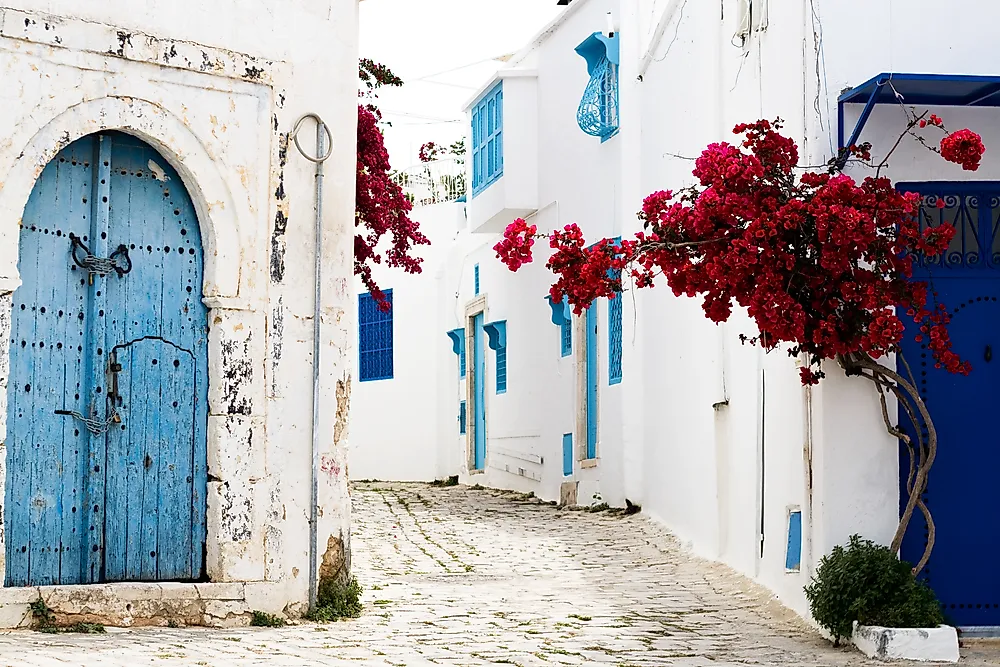Sidi Bou Said, Tunisia - Unique Places Around the World

Sidi Bou Said, Tunisia has magnificent and unique tourist attractions which makes it one of the most unique places in the world.
5. Sidi Bou Said
Sidi Bou Said is a famous tourist attraction in Tunisia, North Africa. The city is located 12.5 miles north of Tunis, the Tunisian capital. It is a small city with a population of around 6,000. The city is easy to access via train from Tunis to La Marsa. Previously, the city was popularly known as Jaba el-Menar. Its current name is in honor of a Tunisian religious figure, Abu Said al-Baji, who lived there between the twelfth and thirteenth centuries. He was a Sufi Wali (Islamic Spiritual leader) who was born in 1156. He moved to Jaba el Menar – current day Sidi Bou Said – in 1207. He strategically built his palatial home on a steep cliff overlooking the Mediterranean Sea, where the city stands today. Its positioning next to the Mediterranean Sea gives the city a cool atmosphere. Until his death in 1231, Abu Said al-Baji had a mass of staunch followers and commanded admiration and respect. A mosque and a shrine stand in his honor to date.
4. Tourism
Sidi Bou Said is a famous tourist destination. Thousands of tourists throng the small city from different parts of the world. During the day, tourists walk along the narrow, stone-paved streets interacting with local vendors and residents. Traders have stalls on the sides of the streets selling unique items and souvenirs that portray the rich history of the city. The traders are very friendly to the visitors hoping to make a sale.
The Mausoleum of Abu Said al-Baji offers great sightseeing views. This site offers incomparable views of the Carthage, the Gulf of Tunis and the capital itself, Tunis.
The city hotels and restaurants offer a range of Tunisian dishes and cuisines. High-quality beverages – especially coffee and tea – are also available in the hotels and coffee shops.
The Museum Dar al-Amabi has lots of fascinating items and souvenirs, which give an insight into the city’s rich history; stories and tales of a city, which have withstood the test of time to become a major tourist attraction.
3. History of the City
From as early as the twelfth century, the city of Sidi Bou Said has attracted tourists from all over the world. Religious leaders, governors, artists, and wealthy individuals have all fallen in love with the blue and white village and built residences there.
Abu Said al-Baji built his residence in the city, which later became a Mausoleum in his honor. He gained a huge following of Islamic faithful eager to hear his teachings. His shrine has become a site of pilgrimage with thousands visiting his tomb every year. In the eighteenth century, Turkish governors of the capital, Tunis built homes in the city.
The beauty, artistry, and artisanship of Sidi Bou Said have attracted thousands of artists, with many taking up residences in the city. Members of the Husseinite dynasty arrived in the city in the eighteenth century bringing with them leading musicians and writers of the day. They all built homes in the city. The famous French writer and musicologist Rodolphe d’Erlanger also settled in the city.
The city has inspired many artists. Paul Klee, Gustave-Henri Jossot, and August Macke arrived there in 1914. In that same year, Macke painted one of the oldest pictures of Sidi Bou Said – the watercolor of Café des Nattes. Arriving in the city was a turning point for Klee. He previously worked on black and brown pictures but switched to light and color graphics upon arrival.
Other artists who lived in the city are French philosopher Michael Foucault and the famous occultist Aleister Crowley.
2. Threats
Tourists on vacation in Sidi Bou Said have been on edge due to the rise of terrorism in Tunisia. Reports indicate that 6,000 Tunisians have joined terror groups fighting in Iraq, Syria, Yemen, and Libya. Unemployment among the young population is one of the reasons behind this large number. The international community has since cautioned tourists against visiting Tunisia. This has been a major blow to tourism in Sidi Bou Said and Tunisia as a whole. Despite the constant terror attacks, the city retains its glamor and uniqueness. Campaigns to restore peace in Tunisia will restore the city’s tourist glow as well.
1. Uniqueness
The city of Sidi Bou Said is truly magnificent and one of the most charming places in the world. All the buildings in the city are painted white with perfect shades of blue. Walking through its narrow streets reveals an incredible mastery of art. The walls and staircases of the age-old buildings are of marble white, while the doors, window frames, shutters, and moucharabiehs are of blue color. Baron, Rodolphe d’Erlanger, who was a French painter and a musicologist, introduced the blue and white theme. The Palace Dar Njema Ezzabra was previously the residence of the baron. This man also introduced the blue and white color scheme that makes the city a beautiful palace.
The Souk – the local market – is a favorite for the tourists. It is located in the upper part of the city and on each side of the main street. Here, traditional buildings with beautiful designs and artwork have turned into stores. Various types of traditional foods, jewelry, leather bags, decorated slippers, and shoes sell at favorable prices for customers from all over the world. Craftsmen design decorated copper doors right on the sides of the streets.











